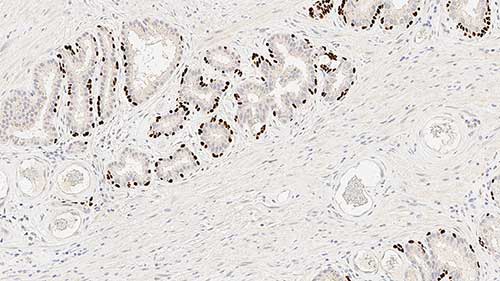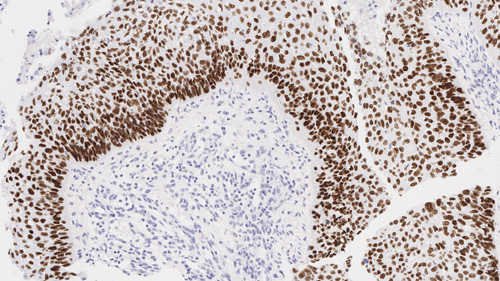8 result(s) for 'P63'
1 - 8 of 8 results for 'P63'
Sort by
Show
Antigen Background
p63 is a type II integral membrane protein predominantly localized in the rough endoplasmic reticulum. p63 is reported to be expressed in a number of normal tissues including proliferating cells of the epithelium, cervix, urothelium and prostate. p63 is also reported to be expressed in most poorly differentiated squamous cell carcinomas.
Disclaimer
p63 Protein is recommended for the detection of specific antigens of interest in...
Antigen Backgroundp40 (Delta Np63) is a truncated product of the p63. It is normally expressed in the basal or progenitor cell layer of stratified epithelia, basal cells of prostate, as well as myoepithelial cells of breast and salivary glands, and cytotrophoblasts in placenta, and shows a nuclear staining pattern with IHC. Among the numerous neoplasms positive for p40, squamous cell carcinomas of pulmonary and non-pulmonary origin can be identif...
It’s Time for TIME Alexander “Sandy” Borowsky Professor of Pathology and Laboratory Medicine Center for Immunology and Infectious Diseases
Disclosures Bristol-Meyers Squibb/Celgene: Funded through Investigator Sponsored Research (ISR) program. Discovery proposal. Leica/Aperio: Funded to run the “Genesis” study for primary diagnosis from whole slide images. Honorarium for this presentation. Histolix: Slide-free histology (Levenson and Fereidouni). Pfizer: Pfizer Protocol A9001502, Treatment Resistance Following Therapies (TRANSLATE) site PI. Agenda: In contracting to join the “FLEX” registry. None of these has actually paid me, only funding for the research projects.
Objectives • Introduction into the complexity of the TIME and the development of new cancer treatments though di...
In surgical pathology more than ever, the laboratories are expected to do more with less. Taking on more specimens with less technical staff, or getting more stains out of tiny biopsies or fine needle aspirations have become the norm. The College of American...
The content of this webinar will encompass detailed technical descriptions of novel and state of the art methods to decalcify tissue samples that will be embedded in paraffin or for frozen sectioning for molecular and nucleic acid analysis for basic research...
Biomarkers
AE1/AE3 (1)
AMACR (2)
BCL6 (1)
CD163 (2)
CD20 (2)
CD3 (9)
CD4 (5)
CD68 (5)
CD8 (10)
CDX2 (2)
CK20 (5)
Ck5 (4)
...
Slide 1
Hello, hello; thank you so much for that introduction. Let's get started. Oh, I'm sorry, I just need to hit this next button here. So my name is Mark Lawson.
Thank you for joining us in this webinar. I'm here to present BOND RX tips, tricks, and optimization. It's going to be a user guide from the BOND RX and chromogenic multiplexing in the research application.
Slide 2
So, my name is Mark Lawson. I'm an application specialist on the Life Sciences team at Leica Biosystems I provide technical support for the Life Sciences portfolio, including but not limited to the BOND RX, the BOND RXm, and a wide array of reagents. So I've worked in the histology field for about 15 years and in both clinical and research spaces. I started off as a histotechnologist and worked my way up...
Different types of cancers frequently metastase to bone tissue. Treatment planning decisions are often based upon histology and special staining of these distant sites of disease. These decisions may rely on the outcome of immunohistochemistry, in situ...

